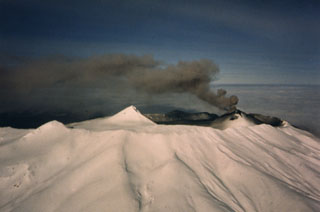Report on Akutan (United States) — July 1988
Scientific Event Alert Network Bulletin, vol. 13, no. 7 (July 1988)
Managing Editor: Lindsay McClelland.
Akutan (United States) Fewer ash and steam emissions
Please cite this report as:
Global Volcanism Program, 1988. Report on Akutan (United States) (McClelland, L., ed.). Scientific Event Alert Network Bulletin, 13:7. Smithsonian Institution. https://doi.org/10.5479/si.GVP.SEAN198807-311320
Akutan
United States
54.134°N, 165.986°W; summit elev. 1303 m
All times are local (unless otherwise noted)
Only two ash ejections from the summit cinder cone were observed after 2 July, representing a marked decrease from March-June ejections. Steam emission was also rare. At 1243 on 4 July, MarkAir captain Norman Lee and co-pilot Myles Thomas observed black ash rising to 3,000 m altitude, drifting NE. At 1644 on 20 July, Peninsula Airways pilot Kim Post observed a dark gray plume rising to 2,400 m altitude, drifting SSE.
Geological Summary. Akutan contains a 2-km-wide caldera with a large cinder cone in the NE part of the caldera that has been the source of frequent explosive eruptions and occasional lava effusion that covers the caldera floor. An older, largely buried caldera was formed during the late Pleistocene or early Holocene. Two volcanic centers are located on the NW flank. Lava Peak is of Pleistocene age, and a cinder cone lower on the flank produced a lava flow in 1852 that extended the shoreline of the island and forms Lava Point. The 60-365 m deep younger caldera was formed during a major explosive eruption about 1,600 years ago and contains at least three lakes. A lava flow in 1978 traveled through a narrow breach in the north caldera rim almost to the coast. Fumaroles occur at the base of the caldera cinder cone, and hot springs are located NE of the caldera at the head of Hot Springs Bay valley and along the shores of Hot Springs Bay.
Information Contacts: J. Reeder, ADGGS.

